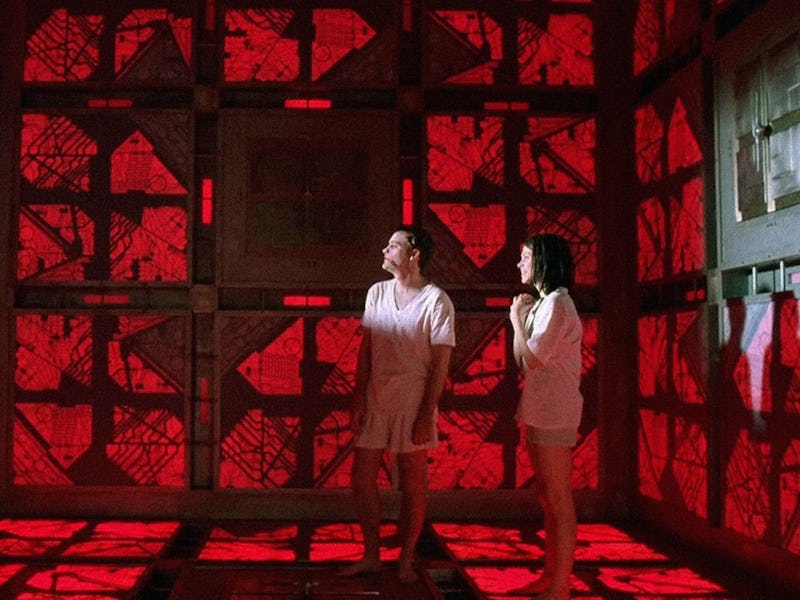An Obscure Indie Horror Remains the Model for How to Execute a Freaky Idea on a Budget
Twenty-five years ago, Canadians built the Torment Nexus.

2023 began with an unexpected hit in Skinamarink which, depending on who you ask, is either terrifying or confounding. Regardless, director Kyle Edward Ball transformed a $15,000 budget into a cool $2.1 million box office. Not bad for a movie filmed in his Edmonton childhood home.
Fittingly, Skinamarink arrived a quarter-century after Cube, another indie Canadian horror, and one that put the country’s growing special effects industry on the map. In it, a cop, a math student, a doctor, an escape artist, a nihilist, and a mentally disabled man wake up in a cube-shaped room with matching jumpsuits and no memory of how they got there. There’s a door on the ceiling, on the floor, and in every wall, each leading to an identical room. But deadly traps lurk in many of them and, when attempts to work around their sensors fail to gruesome results, the team needs to rely on the young mathematician’s understanding of numbers carved into the doors to find their way out.
Filmed with 350,000 CAD (robust compared to Skinamarink, but still the Hollywood equivalent of digging through couch cushions), Cube is a strong example of how a limited budget can encourage creativity rather than squelch it. The movie is, aside from a handful of brief exterior shots, set entirely within the Cube, with only the changing colors of the rooms (really just a single set with the wall panels swapped out) offering any sense of progress.
If Cube were made as a Netflix Original today, there would likely be tedious subplots detailing the motivations and workplace politics of the secret organization responsible for the Cube’s construction, which would completely drain the sci-fi thrills within the maze of their horror and weirdness. But Cube studiously refuses to tell the viewer much of anything. Our heroes theorize that it’s a military experiment, or a billionaire’s plaything, or even an alien construct. But ultimately the Cube exists because it exists, and they’ve just got to deal with it.
The result is a strange, tense, high-concept thriller that still holds up today — despite some dodgy effects and occasional overacting — thanks to the sheer force of its vision. Its inherent claustrophobia is enhanced by disorientating closeups, swooping camerawork, and discordant music that emphasizes our cast’s rapidly deteriorating mental condition. The Cube is harsh and industrial, like a laser tag arena gone horribly awry, and the whole affair feels like an unusually gruesome Terry Gilliam movie, or an edgier Twilight Zone episode (critics noted a strong influence in 1961’s “Five Characters in Search of an Exit”).
The bloody traps were a selling point, but they soon give way to bickering; everyone is kind of an asshole, but you would be too if you were stuck in a Cube. Some clunky dialogue and a portrayal of intellectual disability generously described as dated are Cube’s weak points, although the amateurism pokes through elsewhere too. A shocking final twist makes no objective sense, and our supposedly brilliant mathematician has to stop and think for a while about whether a number that ends in two is prime. The math powering the Cube generally becomes a bit numbing, but the film retains enough tension to make it well worth watching.
This man is about to have a very bad day.
Cube also offers some prime “Hey, it’s that guy!” spotting. A 17-year-old Nicole de Boer played the math whiz years before she became Ezri Dax on Star Trek: Deep Space Nine, while David Hewlett would later have roles in Stargate, Rise of the Planet of the Apes, and The Shape of Water. Co-writer Graeme Manson would go on to create Orphan Black, while director Vincenzo Natali would helm Splice and rack up a solid TV resume. Collectively, they demonstrate the power of indie projects to get people noticed, at least when everything breaks just right.
Cube has an unusual history — it flopped in its native Canada before becoming a box-office smash in France, of all places, while also doing well enough in the States to garner an inferior sequel, an inferior prequel and, eventually, an inferior Japanese remake, none of which benefited from larger budgets and expanded stories. Ultimately making over 25 times its budget, Cube feels like a precursor to Saw, Circle, and other mononymous, high-concept horrors with more ideas than sets. That it was largely the product of government funding makes it especially intriguing; we’re probably not going to get a billion-dollar Joe Biden Cinematic Universe anytime soon, but as Hollywood studios continue to resist making even modest concessions to creators, it’s a reminder that there should be other ways to make art, even when that art features a man getting chopped into sashimi.
It’s also a reminder that big ideas can be deceptively simple. Perhaps the biggest mistake a horror film can make is to overexplain its ideas, bluntly revealing that the real villain is capitalism or that the seemingly innocent man actually deserved to be disemboweled with a chainsaw because he was a bit ungrateful about life. Cube teases at one of Kafka’s gnarlier nightmares unfolding in the background, and fans have read it as “a horrifying philosophical masterpiece” and “a liberal nightmare of doomer politics,” but Cube gets that all of that is superfluous to putting people in a really big Cube. Sometimes, that’s all an entertaining movie needs to do.
This article was originally published on